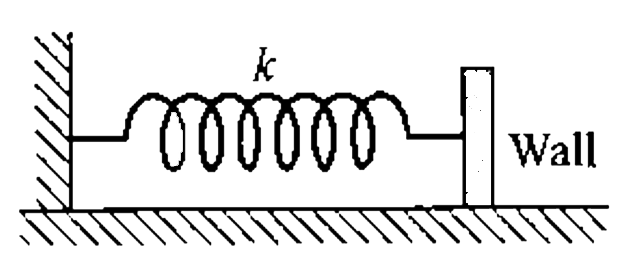Two equal masses are attached to the two ends of a spring of spring constant k. The masses are pulled out symmetricaly tostretch the spring by a length x over its natural length. The work doen by the spring oneach mass is
(i) +12kx2
(ii) −12kx2
(iii) +14kx2
(iv) −14kx2
Topper's Solved these Questions
- WORK , ENERGY & POWER BOOK - NARAYNACHAPTER - WORK , ENERGY & POWER EXERCISE - EVALUATE YOURSELF-1
8 Videos
- WORK , ENERGY & POWER BOOK - NARAYNACHAPTER - WORK , ENERGY & POWER EXERCISE - Evaluate Yourself - 2
8 Videos
- WAVESBOOK - NARAYNACHAPTER - WAVESEXERCISE - Exercise-IV
56 Videos
- WORK POWER AND ENERGYBOOK - NARAYNACHAPTER - WORK POWER AND ENERGYEXERCISE - Level-VI (Integer)
12 Videos
Similar Questions
Two equal masses are attached to the two end of a spring of force constant k the masses are pulled out symmetrically to stretch the spring by a length 2x0 over its natural length. Find the work done by the spring on each mass.
View SolutionTwo blocks of masses m, and m, are connected to the ends of a spring of spring constant k. System is kept at rest on a frictionless horizontal floor with spring in its natural length. Both the blocks are pulled along opposite directions with forces of same magnitude F. Calculate maximum elongation of spring and distances travelled by the blocks during this motion.
View Solution
Knowledge Check
Two equal masses are attached to the two ends of a spring of spring constant k. The masses are pulled out symmetrically to stretch the spring by a length x over its natural length. The work done by the spring on each mass is
A12kx2B−12kx2C14kx2D−14kx2Two equal masses are attached to the two ends of a spring of spring constant k. The masses are pulled a part symmetrically to stretch the spring by a length x over its natural length. The work done by the spring on each mass is.
A12kx2B−12kx2C14kx2D−14kx2Two equal masses are attached to the two ends of a spring of spring constant k. The masses are pulled a part symmetrically to stretch the spring by a length x over its natural length. The work done by the spring on each mass is.
A12kx2B−12kx2C14kx2D−14kx2
A plane mirror having a mass m is tied to the free end of a mass less spring of spring constant k. The other end of the spring is attached to a wall. The spring with the mirror held vertically to the floor on which it can slide smoothly. When the spring is at its natural length, the mirror is found to be moving at a speed of v cm/s. The separation between the images of a man standing before the mirror, when the mirror is in its extreme positions:

View SolutionTwo equal masses are attached to the two ends of a spring of spring constant k. The masses are pulled out ,YI)l~etri~ally to ~tretch the spring by a length· x over its natural length. The work done by the spring on each mass is:
View SolutionAn object of mass m, oscillating on the end of a spring with spring constant k has amplitude A. its maximum speed is
View SolutionA load of mass M is attached to the bottom of a spring of mass 'M/3' and spring constant 'K'. If the system is set into oscillation, the time period of oscillation is
View SolutionWhen a 20 g mass hangs attached to one end of a light spring of length 10 cm, the spring stretches by 2 cm. The mass is pulled down until the total length of the spring is 14 cm. The elastic energy, (in Joule) stored in the spring is :
View Solution
